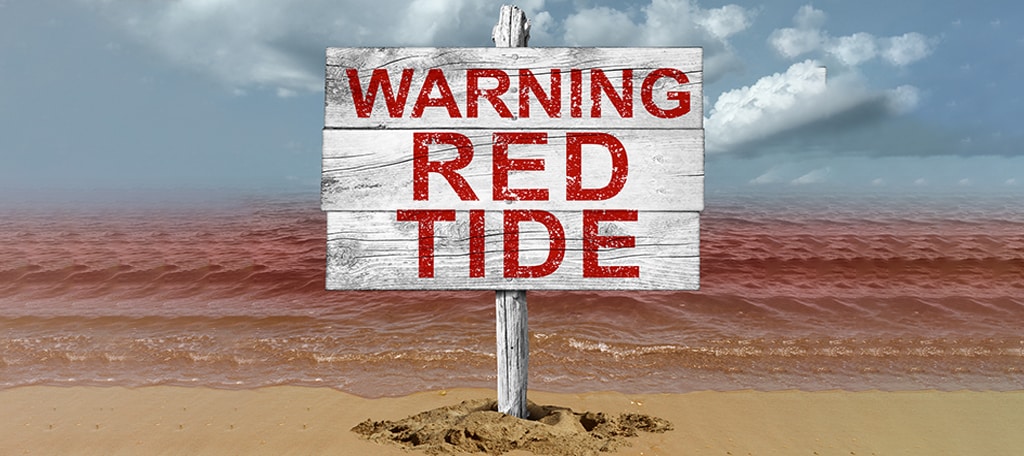
While most summers in Florida are spent on the beach, 2018 was an exception. The 2018 summer saw the worst red tide outbreak in over a decade and kept beachgoers from the ocean, but that is far from the worst part. The red tide has resulted in the massive death tolls of sea life.
Of course, while this was going on, places like SeaWorld in Orlando were actively trying to save the native manatees, dolphins, sea turtles, and other marine life. However, the number of manatees that were affected was enormous.
The amusement park came very close to using every resource available to rehabilitate the manatees. In some cases, they were forced to send young manatees to zoos in Ohio to free up space for new patients. This summer-long event fully tested the resources available for sea life rescue and rehabilitation.
What Causes the Red Tide

Yet, even with the summer over, the red tide continues to plague the west coast of Florida, according to water tests, which increases the flow of new manatees in need of care. The red tide occurs when too many algae grow and will turn the water red. Due to the increase in algae, the oxygen levels in the water will deplete and dangerous toxins are released into the water.
The combination of less oxygen and toxins in the water result in the death of fish and sea mammals alike. They are also dangerous for humans who swim in water. In the Gulf of Mexico, the strand is known as Karenia Brevis, which is exactly what they look for in water tests.
SeaWorld Is Not Alone
While Seaworld may be one of the largest and well-known sea life saviors, they are not alone in this fight. They have partnered with the Colombus Zoo and Aquarium and the Cincinnati Zoo. Both of these institutions have agreed to take in extra sick wildlife due to the desperate need.
Other private entities like the Clearwater Aquarium, Sarasota Mote Aquarium, and Miami Seaquarium have also stepped up to help save sea life. Unfortunately, the Marine Mammal Pathobiology Laboratory in St. Peterburg has been closed all year due to necessary repairs and upgrades. This institution was sorely missed during this crisis.
What Marine Life is in Danger

Essentially all marine life is at risk. The reduced amount of oxygen in the water will directly result in fish death. Without oxygen in the water, they cannot breathe. The toxins will also directly affect them and any food sources that prey on them, including birds and humans.
Most notably are manatees, dolphins, and sea turtles. These creatures are directly responsible for filling up rescue facilities in SeaWorld and other aquariums. Sadly, due to the severity of the issue, not every creature can be saved. Many of the rescue attempts end up as carcass recoveries.
The Biggest Problem is Time
The effects of the red tide are serious and most sea life, like manatees, will require months or potentially years of rehabilitation. Those that recover quickly will not find their homes fully recovered from the red tide. This creates a huge problem, there’s not enough room to keep them and releasing them back into the wild will cause a relapse.
The longer the red tide lasts, the more victims it will claim and the more survivors will need to be treated. The good news is that even though the red tide is still happening, it is much better than it was during the summer.
Just How Many Marine Creatures Have Been Affected
The red tide has persisted for many months and has claimed many victims, but how many is that? The Florida Fish and Wildlife Conservation Commission’s latest report accounted for 193 marine fatalities directly due to the red tide. This number would be far worse in comparison if rescue efforts had not been so persistent.
To put this into perspective, this number is higher than the combination of both previous years combined. The red tide is extremely vicious to bottlenose dolphins. At least 77 bottlenose dolphins have been killed and it has been declared an Unusual Mortality Event (UME).
Animal Care Is Not Free
One of the last things people want to hear in the wake of catastrophic events like this is in the cost, but it is important. These private institutions do not have an infinite source of money. The facilities needed to house these aquatic creatures are not cheap.
The rescue facilities are not the only ones affected. If beachgoers and tourists are not allowed in the ocean, this directly affects the small businesses that rely on these interactions. The effect is so bad, that banks and state-level officials are stepping in to offer relief and promote tourism once the red tide completely ends.

